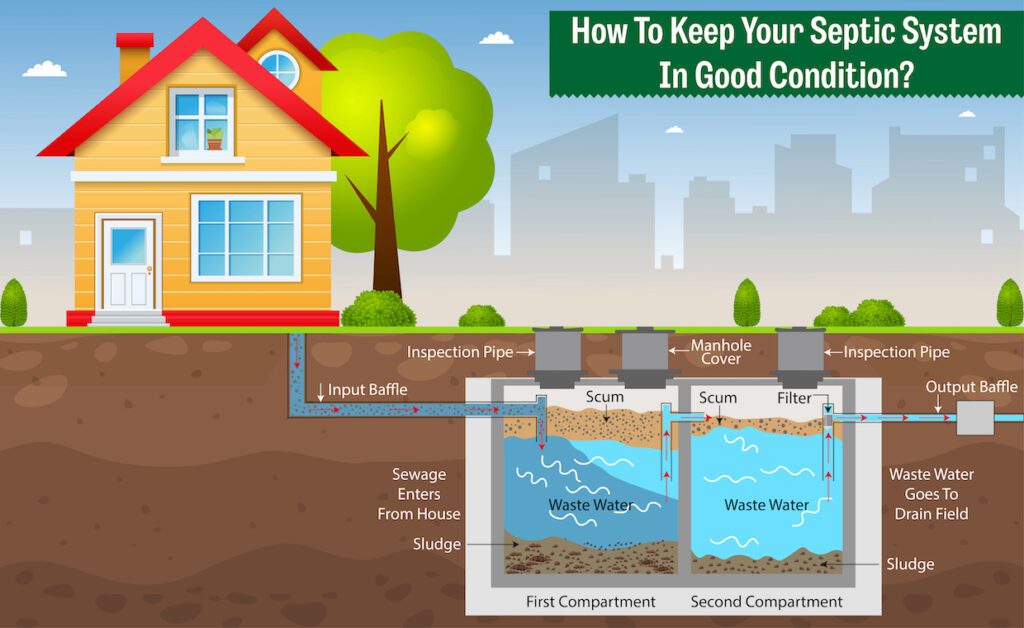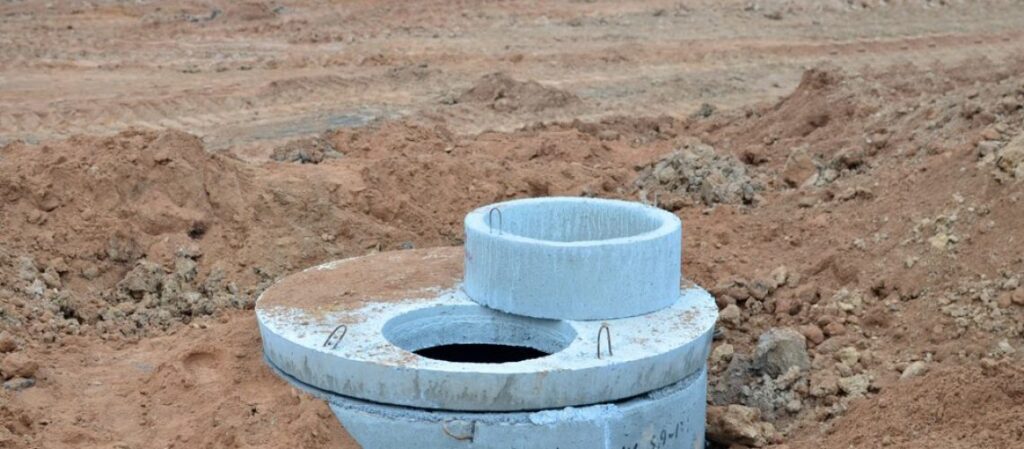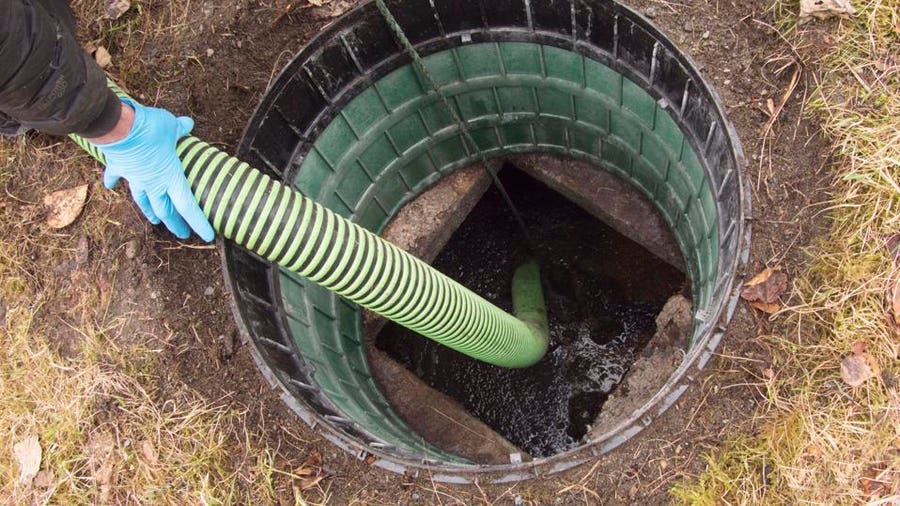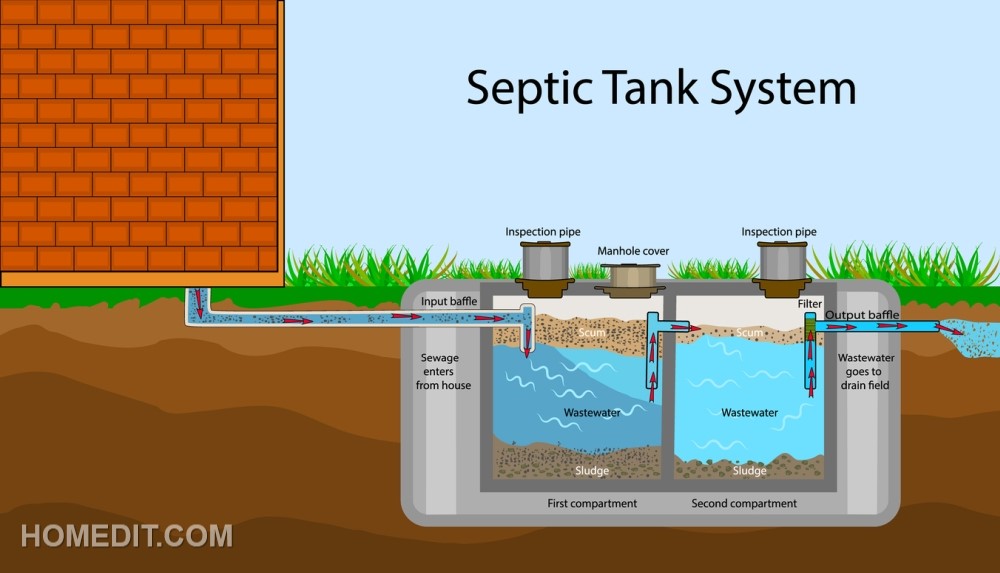In this article, we’ll discuss whether or not you can empty your own septic tank and provide some helpful DIY tips and considerations for homeowners. We’ll explore the benefits and challenges of taking on this task yourself, as well as the necessary precautions and steps to ensure a successful and safe experience. By the end, you’ll have a better understanding of whether emptying your own septic tank is a feasible option for you and how to go about it if you decide to do so.

Understanding Septic Tanks
How septic tanks work
Septic tanks are an integral part of a home’s wastewater treatment system, especially in areas where there is no access to a public sewer system. These underground tanks are designed to hold and treat household wastewater, including water from toilets, showers, sinks, and laundry machines.
The septic tank works by separating solid waste from the liquid waste. When wastewater enters the tank, it undergoes a natural decomposition process where the solid waste settles to the bottom of the tank, forming a layer of sludge. Meanwhile, the liquid waste, known as effluent, floats to the top of the tank.
The effluent then flows out of the septic tank into a drainfield or leach field, where it is further treated by the soil. Bacteria in the soil break down any remaining pathogens and contaminants in the effluent, ensuring that it is safe before it enters the groundwater.
Why regular maintenance is important
Regular maintenance of your septic tank is crucial to keep it functioning properly and prevent costly repairs or environmental contamination. If a septic tank is not well-maintained, the solid waste and sludge can accumulate to the point where it clogs the system or leaks into the drainfield.
When the drainfield becomes clogged, it can cause wastewater to back up into your home, leading to foul odors, plumbing issues, and potential health hazards. In addition, a neglected septic tank may require expensive repairs or even replacement.
By performing regular maintenance on your septic tank, you can ensure its longevity and prevent these problems from occurring. Regular maintenance includes routine inspections, pumping out the accumulated solid waste and sludge, and proper care of the drainfield.
Signs that your septic tank needs to be emptied
It’s important to keep an eye out for signs that your septic tank needs to be emptied. Some common indicators include:
-
Slow drains: If your sinks, toilets, or showers are draining slowly, it may be a sign that your septic tank is nearing its capacity and needs to be pumped.
-
Odors: Foul smells coming from your drains, yard, or around the septic tank itself can be an indication that the tank needs to be emptied.
-
Standing water: Puddles of water or soggy areas in your yard near the septic tank or drainfield may signal a problem with your septic system, potentially indicating that the tank needs to be emptied.
-
Sewage backup: If sewage backs up into your home, it is a clear indication that your septic tank is full and needs immediate attention.
If you notice any of these signs, it’s important to address the issue promptly to avoid further damage or health hazards.
DIY vs Professional Assistance
Pros and cons of emptying your own septic tank
Emptying your own septic tank can be a cost-effective option, especially for mechanically inclined homeowners. However, it is important to consider the pros and cons before undertaking this task.
Pros of emptying your own septic tank:
-
Cost savings: Hiring professionals to pump your septic tank can be expensive, and by doing it yourself, you can save a significant amount of money.
-
Convenience: By being in control of the process, you can schedule the maintenance at a time that is convenient for you, without having to wait for a professional appointment.
-
Learning experience: Emptying your septic tank yourself allows you to familiarize yourself with the inner workings of your septic system and gain valuable knowledge for future maintenance.
Cons of emptying your own septic tank:
-
Potential health hazards: Handling sewage waste can expose you to harmful bacteria and pathogens, which can lead to serious illnesses. It is crucial to take proper safety precautions when emptying a septic tank.
-
Equipment and knowledge requirements: Emptying a septic tank requires specialized equipment such as a pump, hoses, and protective gear. Additionally, it is essential to have a good understanding of how the system works to avoid causing damage or contamination.
-
Local regulations: Some areas may have specific regulations or require permits for septic tank maintenance. Before attempting to empty your tank, it’s important to familiarize yourself with the local rules and regulations.
Benefits of hiring professional septic tank services
While emptying your own septic tank can be a viable option for some homeowners, many others choose to hire professional septic tank services for various reasons:
-
Expertise and experience: Professional septic tank service providers have the knowledge and experience to safely and efficiently empty septic tanks. They are familiar with local regulations and can ensure proper disposal of the waste.
-
Proper equipment: Professionals have access to specialized equipment and tools specifically designed for septic tank maintenance. This equipment allows for thorough cleaning and removal of solid waste and sludge.
-
Time-saving and convenience: Hiring professionals eliminates the need for homeowners to invest time and effort into emptying their septic tanks. They can focus on other tasks while the experts take care of the maintenance.
-
Preventative maintenance: Professional septic tank services often offer additional services such as inspections and preventive maintenance. This ensures that potential issues are identified early on, saving homeowners from future problems and expenses.
Ultimately, the decision between DIY emptying and professional assistance depends on your comfort level, available resources, and the specific requirements of your septic tank.
Important Tools and Equipment
Essential tools for septic tank maintenance
To safely and effectively empty your septic tank, you will need the following tools and equipment:
-
Septic tank pump: A septic tank pump is specifically designed to remove the sludge and liquid waste from your septic tank. It is important to choose a pump that has enough capacity to handle your tank size.
-
Hoses: High-quality hoses that are resistant to chemicals and sewage waste are essential for connecting the pump to the septic tank and directing the waste to an appropriate disposal location.
-
Personal protective equipment (PPE): Proper safety gear, such as gloves, goggles, and coveralls, is crucial to protect yourself from potential health hazards associated with sewage waste.
-
Shovels and rakes: These tools will help you access and remove any obstructions or debris around the septic tank or access points.
-
Access tools: Depending on the design of your septic tank, you may require tools such as a lid lifter, wrench, or pry bar to access the tank’s compartments and inspection ports.
Safety gear and precautions
When working with a septic tank, it is essential to prioritize safety and take appropriate precautions. Here are some important safety tips:
-
Use personal protective equipment (PPE): Wear gloves, goggles, and coveralls to protect yourself from potential hazards. Avoid wearing loose-fitting clothing that may get caught in machinery.
-
Ventilate the area: Make sure the area around the septic tank is well-ventilated to minimize exposure to harmful gases and odors.
-
Stay away from open flames: Avoid working with a septic tank near open flames or sparking equipment, as the fumes produced can be highly flammable.
-
Avoid smoking: Smoking near the septic tank or during any step of the maintenance process is extremely dangerous and should be strictly prohibited.
-
Follow proper disposal protocols: Dispose of the waste in accordance with local regulations and guidelines. Never dump sewage waste in storm drains, bodies of water, or areas that can contaminate the environment.
Following these safety guidelines will help ensure a safe and efficient septic tank maintenance process.
Step-by-Step Guide to Emptying a Septic Tank
Emptying a septic tank involves several steps that should be followed carefully to ensure proper maintenance. Here is a step-by-step guide:
Locating the access points
The first step is to locate the access points of your septic tank. Common access points include inspection ports, cleanout pipes, or central distribution boxes. These access points will allow you to open the tank and access the compartments.
Properly shutting off water supply and electricity
Next, it is important to shut off the water supply to prevent any additional wastewater from entering the tank during the maintenance process. This can usually be done by locating the main water valve in your home.
Additionally, if your septic tank has an electrical component, such as a pump or alarm system, make sure to turn off the electricity before opening the tank.
Using a pump to remove the sludge
Once you have access to the septic tank, it is time to start removing the sludge. Using a septic tank pump, carefully insert the pump into the tank and start pumping out the solid waste and liquid effluent. Follow the manufacturer’s instructions for operating the pump.
Be sure to pump out the sludge evenly from all areas of the tank to ensure thorough cleaning. Pay attention to the liquid levels in the tank to determine when it is fully drained.
Disposing of the waste properly
Proper disposal of the waste is crucial to prevent environmental contamination. The waste should be disposed of in accordance with local regulations and guidelines.
Contact your local waste management facility or septic service provider to determine the appropriate disposal method. They can provide guidance on where to dispose of the waste or arrange for it to be professionally taken care of.
Refilling the tank with water
After the tank has been emptied, it is important to refill it with water to re-establish the proper balance of bacteria and enzymes in the tank. This will aid in the decomposition process and maintain the overall health of the system.
Remember to follow all safety precautions and use the necessary tools and equipment throughout the entire process.

Considerations and Challenges
Local regulations and permits
Before attempting to empty your septic tank, it is essential to familiarize yourself with the local regulations and requirements regarding septic system maintenance. Some areas may have specific rules or require permits for septic tank pumping.
Contact your local health department or septic system professionals to obtain the necessary information and ensure compliance with the local regulations.
Health hazards and precautions
Working with sewage waste poses potential health risks. Sewage contains harmful bacteria, viruses, and parasites that can cause severe illnesses if proper safety precautions are not followed.
Always wear personal protective equipment (PPE), including gloves, goggles, and coveralls, to minimize exposure to pathogens. Wash your hands thoroughly after completing the maintenance process.
Difficulties in handling heavy equipment or waste
Emptying a septic tank can be physically demanding, especially when dealing with heavy equipment or waste. It is important to assess your physical capabilities and determine if you are able to handle the task safely.
If you have any doubts about your ability to safely complete the maintenance process, it is advisable to seek professional assistance.
Common Mistakes to Avoid
Overfilling the tank
One common mistake homeowners make is neglecting regular septic tank maintenance and allowing the tank to become overfilled with solid waste and sludge. This can lead to clogs, backups, and potential damage to the system.
To avoid this mistake, schedule regular septic tank inspections and pumpings according to the recommendations of septic system professionals or local regulations.
Using improper cleaning agents
Certain household cleaners, such as bleach, antibacterial soaps, and strong chemicals, can disrupt the natural balance of bacteria in the septic tank. Avoid using these products excessively or opt for septic-safe alternatives.
Using too many chemicals can kill the beneficial bacteria in the tank, impairing the decomposition process and potentially damaging the system.
Not properly maintaining the drainfield
The drainfield plays a crucial role in the treatment of effluent from the septic tank. Neglecting proper care and maintenance of the drainfield can lead to system failures and expensive repairs.
Avoid parking vehicles or heavy equipment on the drainfield, as this can compress the soil and impair its ability to treat the effluent. Additionally, avoid planting trees or shrubs with extensive root systems near the drainfield, as they can cause damage.

When to Call a Professional
While DIY maintenance can be an option for some homeowners, there are certain situations where it is best to call a professional septic tank service:
Complex septic tank issues
If you encounter complex septic tank issues, such as leaks, structural damage, or malfunctioning components, it is recommended to seek professional assistance. These issues require specialized knowledge and expertise to diagnose and repair properly.
Inability to locate access points
If you are unable to locate the access points of your septic tank or are unsure how to properly open and access the tank, it is safer to contact a professional. They have the necessary tools and experience to locate and access the tank without causing any damage to the system.
Lack of experience or knowledge
If you are unfamiliar with septic tank systems or lack the necessary knowledge and experience to safely and effectively maintain the system, it is advisable to hire professional services. They can ensure the job is done correctly while minimizing potential risks.
Cost Analysis
Comparing DIY expenses and professional service costs
When considering whether to empty your own septic tank or hire professional assistance, it’s important to factor in the potential costs:
DIY Expenses:
- Equipment: Purchasing or renting the necessary equipment, such as a septic tank pump and hoses, can incur initial expenses.
- Disposal: Public waste disposal facilities may charge a fee for properly disposing of the waste pumped from the septic tank.
- Time and effort: Emptying a septic tank can be time-consuming and physically demanding, requiring your personal time and effort.
Professional Service Costs:
- Service fees: Professional septic tank service providers charge a fee for pumping and maintaining your septic tank.
- Additional services: Some companies may offer additional services, such as inspections and preventive maintenance, which may result in additional costs.
When contemplating the costs, it is important to consider your budget, available resources, and the specific needs of your septic system.
Considering long-term savings
While DIY septic tank maintenance can save you money upfront, it’s crucial to consider the long-term savings associated with professional services. Regular professional maintenance can help identify and address potential issues before they become costly repairs.
By investing in professional septic tank services, you can potentially avoid system failures, emergency repairs, or even premature replacement of the entire septic system. These long-term savings can outweigh the costs of hiring professional assistance.

Benefits of Regular Septic Tank Maintenance
Preventing costly repairs
Regular maintenance, including septic tank pumping and inspections, can help identify and address potential issues early on, preventing them from evolving into expensive repairs.
By detecting leaks, clogs, or other problems in the early stages, you can address them promptly, saving yourself from the inconvenience and expense of extensive repairs.
Protecting the environment
A properly maintained septic tank and drainfield are essential in preventing pollution and protecting the environment. Regular maintenance ensures that the effluent from the septic tank is properly treated, reducing the risk of contamination to groundwater and nearby water bodies.
By taking care of your septic system, you are doing your part to preserve the quality of the environment and safeguarding the health of your community.
Ensuring the longevity of the septic system
Regular septic tank maintenance can significantly extend the lifespan of your septic system. Pumping out the accumulated solid waste and sludge prevents clogging and damage to the drainfield, promoting the overall health and efficiency of the system.
By investing in regular maintenance, you can maximize the lifespan of your septic system, potentially saving yourself from the expense and inconvenience of premature replacement.
Conclusion
Emptying your own septic tank can be a viable option for mechanically inclined homeowners who are willing to invest the time and effort into proper maintenance. However, it is crucial to consider the potential risks and challenges associated with this task.
Seeking professional assistance for septic tank maintenance can provide peace of mind, as well as save you time and effort. Professionals have the expertise, knowledge, and equipment required to safely and efficiently maintain your septic system.
Ultimately, the decision between DIY emptying and professional assistance should be based on your comfort level, available resources, and specific septic system needs. Prioritize regular maintenance to prevent costly repairs, protect the environment, and ensure the longevity of your septic system.

